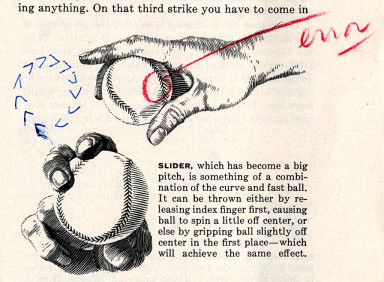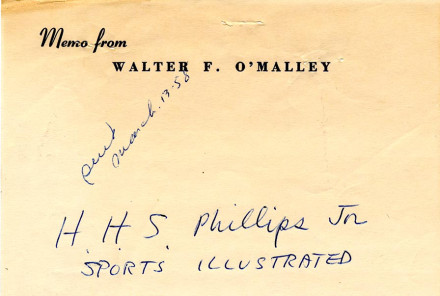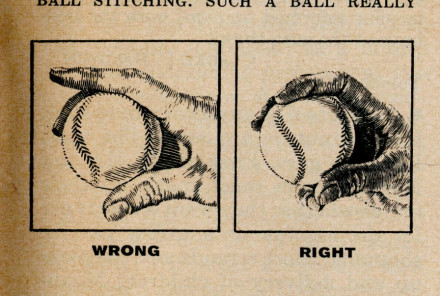Short Stops
Good Catch
He never threw a pitch in a Major League game, and he did not have a doctorate in physics, but Walter O’Malley’s sharp eye could spot a flaw in the illustration of a baseball.
The March 17, 1958 issue of Sports Illustrated began a five-part weekly series on the particular skills of Major League baseball pitchers. Among the areas covered in the series were pitching, catching, hitting, infield play, outfield play and baserunning. The magazine’s first segment was a discussion on pitching by veteran Sal Maglie.

An illustration by artist Anthony Ravielli of the two-seam fastball grip of Sal Maglie for a Sports Illustrated article in March, 1958. It is here that Dodger President Walter O’Malley sees a mistake in the illustration of the baseball and writes “error.”
The determined competitor, Maglie, also known as “The Barber” for pitching in tight to hitters, provided the insight to writer Roy Terrell on pitching successfully in the Major Leagues. Accompanying the article were illustrations of Maglie’s pitching style by artist Anthony Ravielli.
As part of the magazine coverage on the subject, Maglie discussed pitching grips on the baseball for various pitches as Maglie’s fastball, curve and slider. Each grip on a baseball was “illustrated” by the artist.
However, on page 37 of the article, one great baseball fan who also happened to own a Major League team noticed a discrepancy in the illustration of the baseball Maglie gripped to throw the slider.
Walter O’Malley wrote a note to H.H.S. Phillips, Jr., the publisher of Sports Illustrated advising him of the incorrectly drawn baseball.
“3 sketches, page 37” wrote Walter O’Malley, “show impossible stitching on baseball. Such a ball would really do tricks for Sal. Sorry Anthony (Ravielli, the artist), a common error.”

A written note later sent by telegram from Walter O’Malley to Sports Illustrated publisher H.H.S. Phillips informing him of the mistaken illustration of a baseball.

The response by Sports Illustrated in their “Letters to the Editor” section stating that Walter O’Malley had correctly spotted a mistake in the illustration of a baseball and how the baseball stitches should actually appear.
The baseball as drawn by the artist had the stitching on the baseball running together in the same direction on one panel. A stitching of this type would give the pitcher a remarkable advantage in the movement of the baseball.
Sports Illustrated checked the advice and agreed with O’Malley. They printed O’Malley’s note to SI and published this response in the “The 19th hole,” the letters to the editor section in the magazine.
[Mr. O’Malley is] “Right. The stitching on regulation baseball runs continuously so that a ball viewed head-on has its V stitches running down one side but up the other.”
A lot of Dodger pitchers would have loved to throw a baseball illustrated like that!

